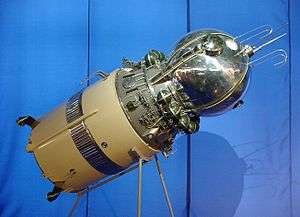Korabl-Sputnik 4
Korabl-Sputnik 4[1] (Russian: Корабль-Спутник 4 meaning Ship-Satellite 4) or Vostok-3KA No.1, also known as Sputnik 9 in the West,[2] was a Soviet spacecraft which was launched in 1961. Carrying the mannequin Ivan Ivanovich, a dog named Chernushka, some mice and a guinea pig, it was a test flight of the Vostok spacecraft.[3]
| Mission type | Biological Technology |
|---|---|
| Harvard designation | 1961 Theta 1 |
| COSPAR ID | 1961-008A |
| SATCAT no. | 91 |
| Mission duration | 1 hour, 41 minutes |
| Spacecraft properties | |
| Spacecraft type | Vostok-3KA |
| Manufacturer | OKB-1 |
| Launch mass | 4,700 kilograms (10,400 lb) |
| Start of mission | |
| Launch date | 9 March 1961, 06:29:00 UTC |
| Rocket | Vostok-K 8K72K s/n E103-14 |
| Launch site | Baikonur 1/5 |
| End of mission | |
| Landing date | 9 March 1961, 08:09:54 UTC |
| Orbital parameters | |
| Reference system | Geocentric |
| Regime | Low Earth |
| Perigee altitude | 173 kilometres (107 mi) |
| Apogee altitude | 239 kilometres (149 mi) |
| Inclination | 64.93 degrees |
| Period | 88.6 minutes |
Sputnik program | |
Korabl-Sputnik 4 was launched at 06:29:00 UTC on 9 March 1961, atop a Vostok-K carrier rocket flying from Site 1/5 at the Baikonur Cosmodrome.[1] It was successfully placed into low Earth orbit. The spacecraft was only intended to complete a single orbit, so it was deorbited shortly after launch, and reentered on its first pass over the Soviet Union. It landed at 08:09:54 UTC, and was successfully recovered. During the descent, the mannequin was ejected from the spacecraft in a test of its ejection seat, and descended separately under its own parachute.[4]
References
- McDowell, Jonathan. "Launch Log". Jonathan's Space Page. Retrieved May 27, 2019.
- Wade, Mark. "Vostok". Encyclopedia Astronautica. Archived from the original on 29 June 2011. Retrieved 27 July 2010.
- Gray, Tara (1998). "A Brief History of Animals in Space". National Aeronautics and Space Administration. Retrieved 3 May 2007.
- Wade, Mark. "Soyuz". Encyclopedia Astronautica. Archived from the original on 7 January 2010. Retrieved 28 July 2010.
